The stories behind the theses
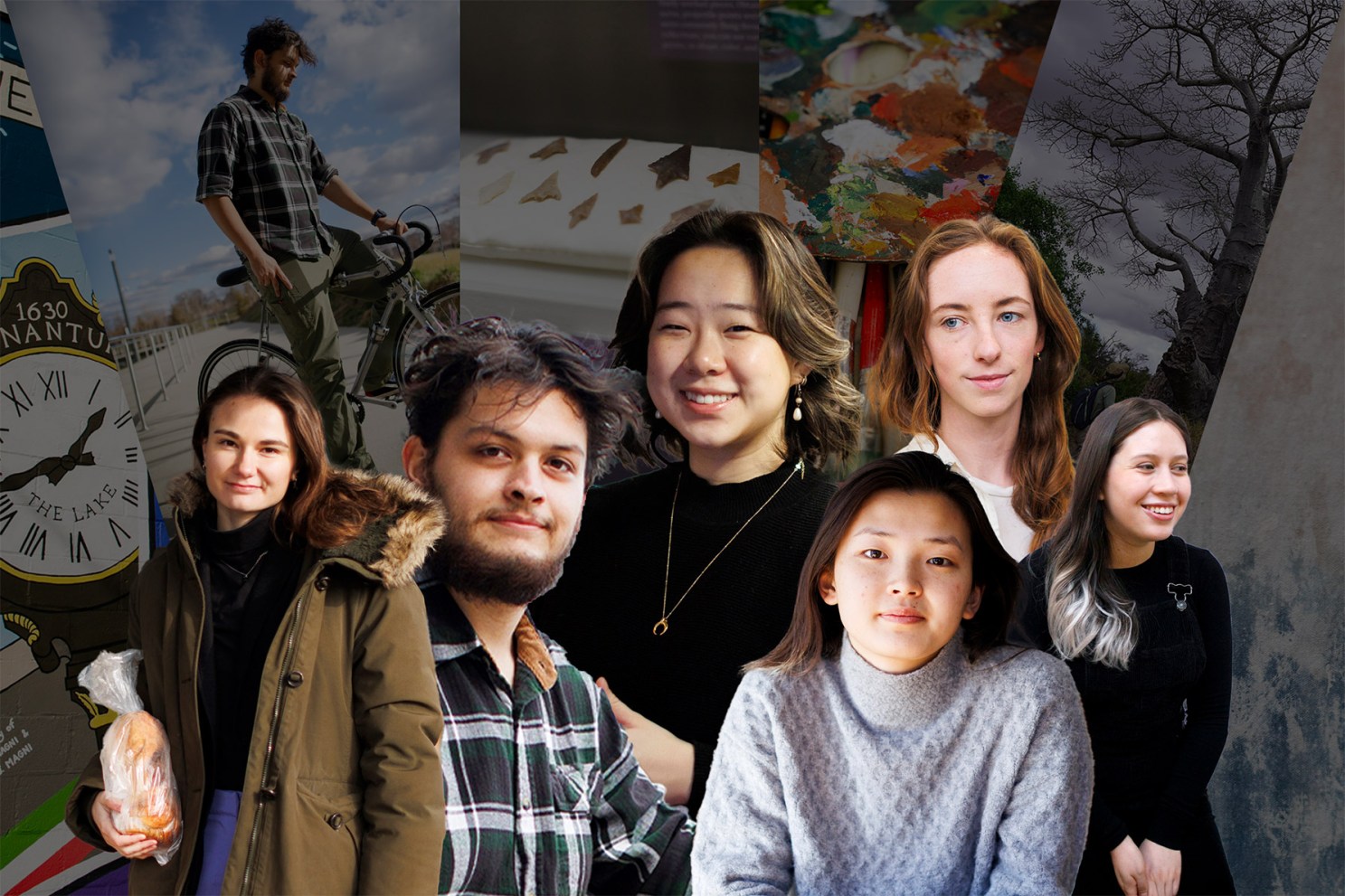
Photo illustration by Liz Zonarich/Harvard Staff
Six students share their inspirations and outcomes
From African baobabs to virtual reality, here is a closer look at six thesis projects Harvard students undertook this year.
In the suburbs
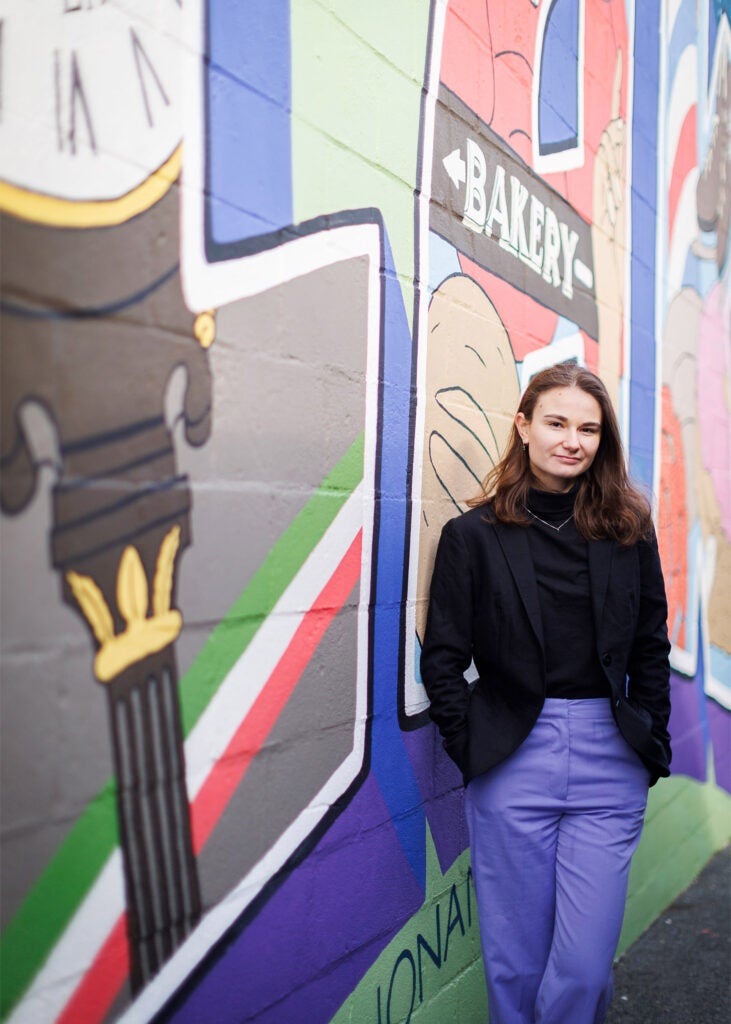
Madeline Ranalli is pictured alongside a mural promoting Nonantum, one of 13 villages within her hometown of Newton, Massachusetts.
Stephanie Mitchell/Harvard Staff Photographer
In leafy suburbs across the U.S., residents have rallied to block affordable housing from their neighborhoods.
“A lot of the resistance comes in the form of people saying, ‘Look what this development is going to do to the trees,’” noted Madeline Ranalli ’23.
The government concentrator (with a secondary in energy and environment) used her senior thesis to examine how these communities wield environmentalism in opposition to multifamily residential developments.
“There’s this misconception that the more green you see, the more environmentally friendly a place is,” Ranalli explained. “But the way a community is designed can actually undermine the environmental benefits of those natural resources.”
The thesis analyzes four car-centric suburbs in California’s Bay Area, where the shortage of affordable housing is especially stark. The region is the birthplace of mainstream American environmentalism and has a history of resistance to multifamily housing. But it’s also a place where lawmakers are passing leading-edge legislation to bolster affordability and density.
Ranalli conducted dozens of in-person interviews, and worked with the Harvard Digital Lab for the Social Sciences to survey the nationwide frequency of using environmentalism to oppose land use that would actually reduce carbon footprints.
“This is by no means unique to California,” said Ranalli, who grew up observing similar rhetoric in her hometown of Newton, Massachusetts. “It’s very much a phenomenon in affluent, Democratic suburbs.”
While conducting research, Ranalli, now a legislative intern with the U.S. Senate Committee on Environment and Public Works, discovered “The Environmental Protection Hustle” (1979) by the late MIT urban planning professor Bernard J. Frieden, which helped inform her argument that environmentalism is more than an ideology about the importance of protecting natural resources.
“It’s also a very legitimate political strategy that can be employed very successfully to achieve certain ends,” Ranalli said.
Across the savannas
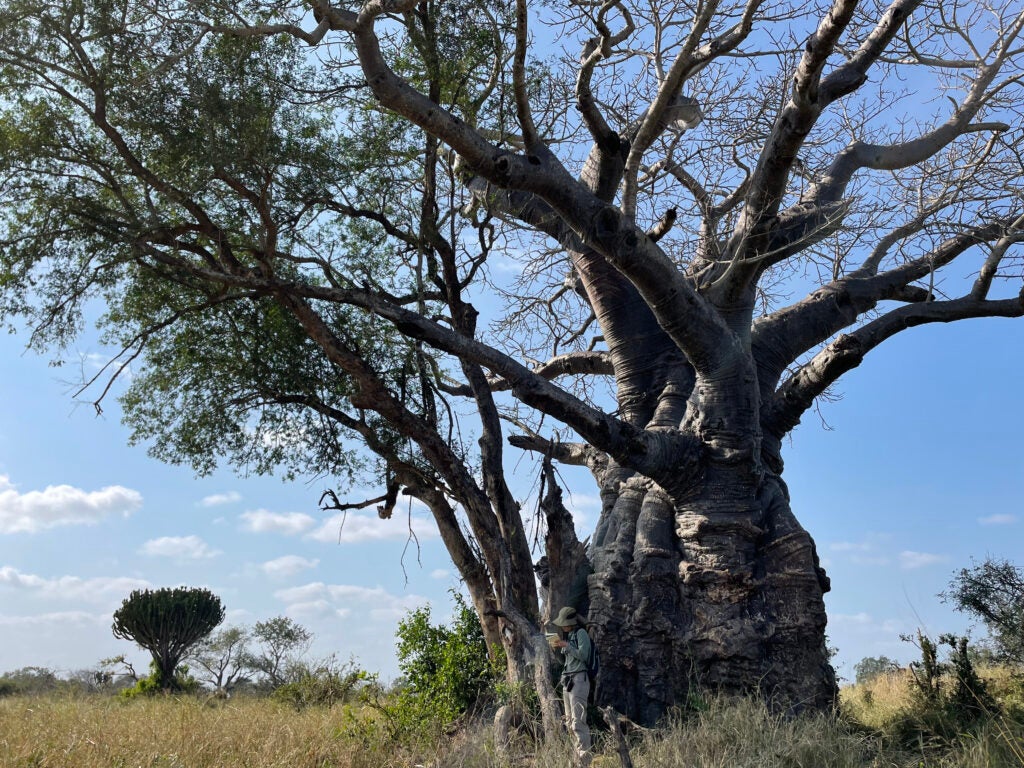
Audrey “Rey” Chin in Mozambique studying baobab trees.
Courtesy photo
Last summer, Audrey “Rey” Chin ’24 hiked 125 miles across dense savanna in Mozambique, painstakingly collecting data from more than 100 trees that make up a delicate, changing ecosystem.
An Environmental Science and Public Policy program concentrator, Chin wrote her senior thesis on the distribution and vulnerability of African baobabs, the largest fruit-bearing trees on the planet, which carry both ecological and cultural significance for the region. Elephants use these iconic trees as nutrient sources, stripping their bark, extracting water, and eating them. In doing so, they spread the seeds to help the trees reproduce.
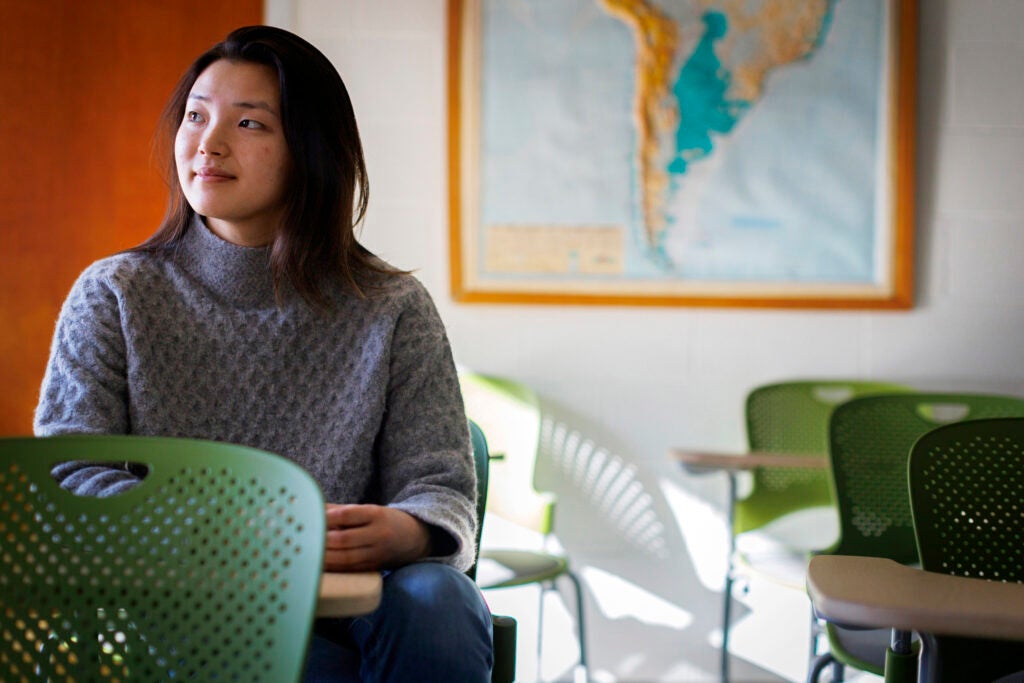
Chin wrote her senior thesis on the distribution and vulnerability of African baobabs.
Stephanie Mitchell/Harvard Staff Photographer
Chin’s thesis integrates her field study with remote sensing data to evaluate the extent to which landscape variables, including elephants, affect the health of baobabs. Chin is conducting the research in the lab of Andrew Davies, assistant professor of organismic and evolutionary biology.
“I think [the project] is ultimately about trying to find a way to balance the conservation priorities of the two species, and understand the interaction that’s happening,” she said.
The remote Karingani Game Reserve in southern Mozambique, where Chin and classmate/labmate Hannah Adler ’25 conducted the field work, is a test bed for understanding the current level of elephant utilization of the trees, and how that relationship could inform stewardship and conservation practices for years to come. The area came under official protection in 2017. Since then, migration from nearby Kruger National Park as well as anti-poaching and landscape restoration measures have led to a surge in the elephant population.
“The opportunity to witness the biodiversity and interconnectivity of different species was probably the most awe-inspiring part of the project,” Chin said.
In the workshop
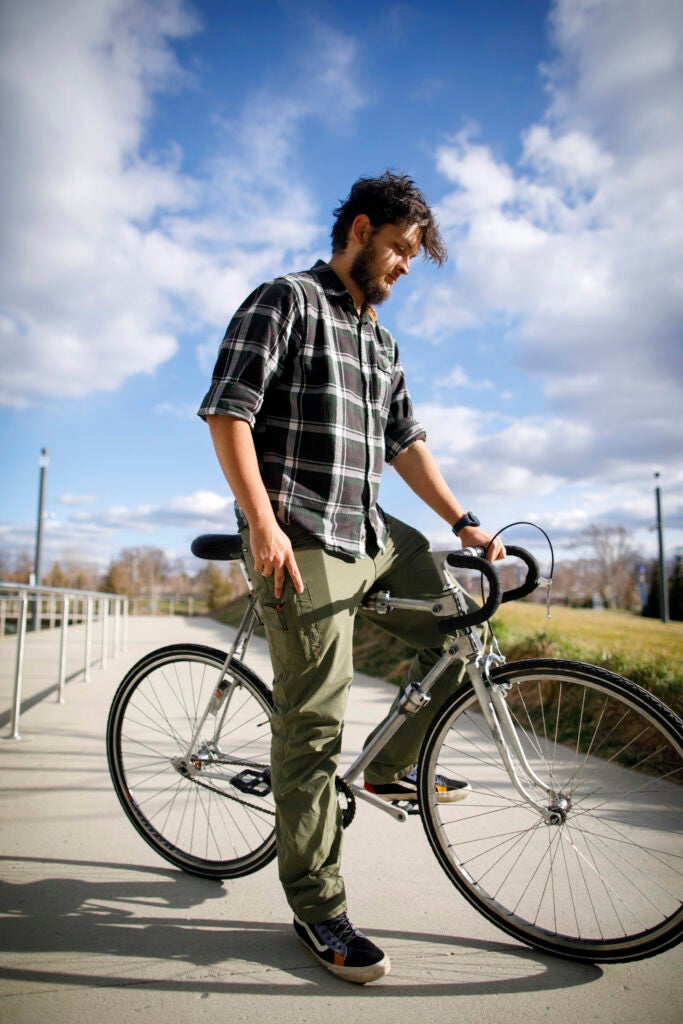
Francisco Marquez with his prototype bicycle.
Photos by Stephanie Mitchell/Harvard Staff Photographer
Francisco Marquez ’24 had always ridden bicycles, but it was pandemic-fueled restlessness during his freshman year that led the mechanical engineering concentrator to learn how to build them.
Now the de facto bike mechanic of his friend group, Marquez pursued a senior capstone project that tackled a perennial problem for two-wheeled enthusiasts like him: size.
“Because I’m a fairly large person, most bikes don’t fit me,” said Marquez, who is 6 foot 4. “I also have a bunch of friends who are very small, and they also can’t find a bike that really fits them. I decided to try to make a bike that could fit everybody.”

Marquez designed and built a modular bicycle frame with a shape and size that can be adjusted to fit very short people, very tall people, and everyone in between. It also allows children to grow into their wheels.
“It could even be something that you buy for a teenager, that they can then use as they grow into adulthood,” he said.
Simplifying the frame into standard components such as top tube, down tube, and fork, Marquez redesigned each piece with unlocking mechanisms using joints and pins, allowing for rotating, loosening, and retightening. Manufacturing was no simple task; it took a year’s worth of testing to find the right materials and configuration for a bike that could be adjusted easily yet remain reliably rigid during use. He settled upon a retrofit of a vintage steel-framed bicycle and created his own custom parts. Throughout the process, Marquez picked up skills like welding and spent many hours in the Science and Engineering Complex machine shop, working with tools like a lathe and a mill.
Testing it for the first time in its tallest configuration, Marquez smiled when it fit like a glove. He said it was gratifying to be able to see his own design come to life.
“I’ve never ridden a bike that feels like this,” he said.
In the gardens
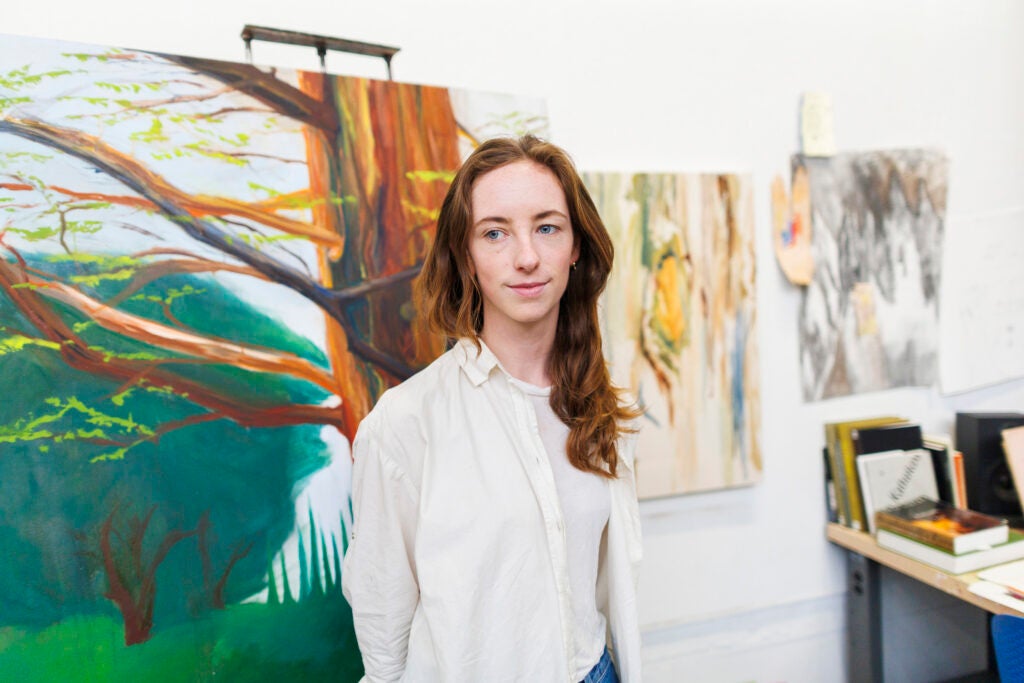
Rivers Sheehan in her studio space on Linden Street.
Photos by Stephanie Mitchell/Harvard Staff Photographer
In the southern colonies of 18th-century America, the science of botany was used for economic purposes but also for aesthetics, using beautiful gardens and cultivated landscapes to mask a brutal plantation economy.
Rivers Sheehan ’23, a joint concentrator in art, film, and visual studies and history of science, completed a thesis project that combined historical research with an art exhibit, examining how botany, considered a gentlemanly European science in the 18th century, found new roots in the U.S.
“I looked at how that epistemology got applied in the South, in the frontier lands where people were both setting up really profitable and violent plantations using botanical knowledge and also setting up estate gardens that were inspired by French and English landscape design, often on the same properties,” said Sheehan, who wrote a 90-page paper detailing her findings.
For the art element, the December 2023 graduate created a multimedia exhibit of paintings, photographs, prints, and drawings inspired by her research at the plantations and also her own relationship to the natural world. Some of the pieces use paper dyed with natural indigo, birch bark, rabbit skin glue, leaves, and wild mushrooms. Sheehan worked in a variety of media, each representative of a different modality she learned during her time at Harvard.
“The studio project is a way of bringing this niche research into the contemporary moment and offering another way for an audience to come into it who isn’t necessarily an academic historian of science, which is the audience for the written part of it,” Sheehan explained.
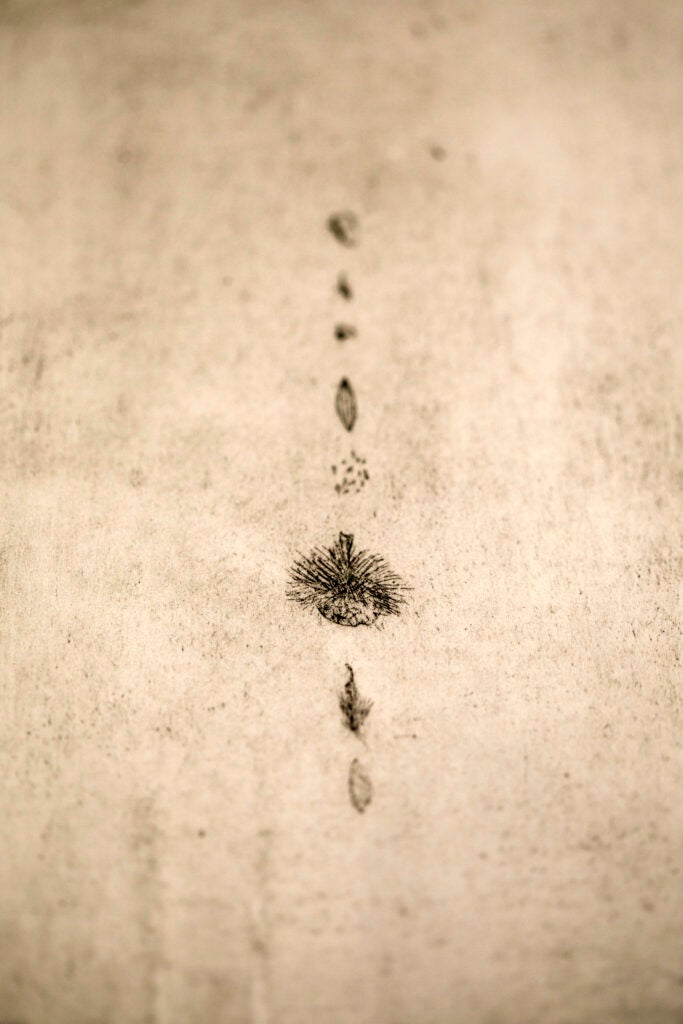
Stepping back in time
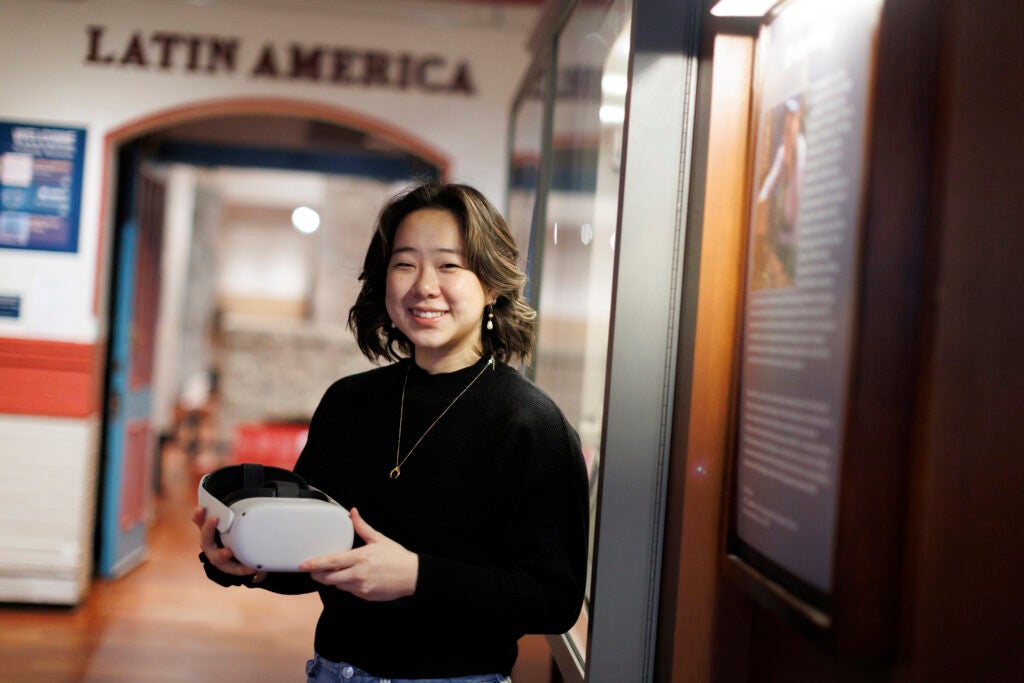
Cindy Tian created a virtual reality program.
Photos by Stephanie Mitchell/Harvard Staff Photographer
Virtual reality can facilitate all manner of educational experiences — like bringing visitors inside the Pyramids of Giza. Cindy Tian ’23, a joint concentrator in computer science and archaeology, wondered how the technology would fare with more complicated lessons.
“I wanted to see if VR can show archaeological processes that are harder for the general public to understand,” she said. “Would the technology improve the transfer of information from archaeologists and museum staff?”
Her thesis took the form of an exhibit for the Peabody Museum of Archaeology and Ethnography, still on view near the third-floor stairwell. Tian first created a display featuring artifacts that illuminate flintknapping — or fashioning blades, points, and other tools from a stone core. On view are everything from hammerstones to chipping tools.

Tian, a December grad, also created a virtual reality program that allowed visitors to simulate making their own tools with objects like the ones on display.
“Flintknapping is a reductive process where you basically remove pieces of rock,” said Tian, who will soon start a full-time role with a music analytics startup. “It’s just one of the things where it’s better to learn by doing rather than reading or hearing someone talk about it.”
Finally, Tian tested who learned best about flintknapping — those who took in the exhibit, those who used the VR program, or those who encountered both.
“Are we integrating VR because it’s cool? Or is it actually helpful?” she wondered.
Those who experienced both the exhibit and the VR scored highest on Tian’s post-visit content quiz. The same group emerged with more positive opinions of the flintknapping lesson.
“They essentially got to do it without doing it,” Tian said. “I found that the virtual reality is definitely beneficial for helping people learn about archaeological processes.”
Working in the studio
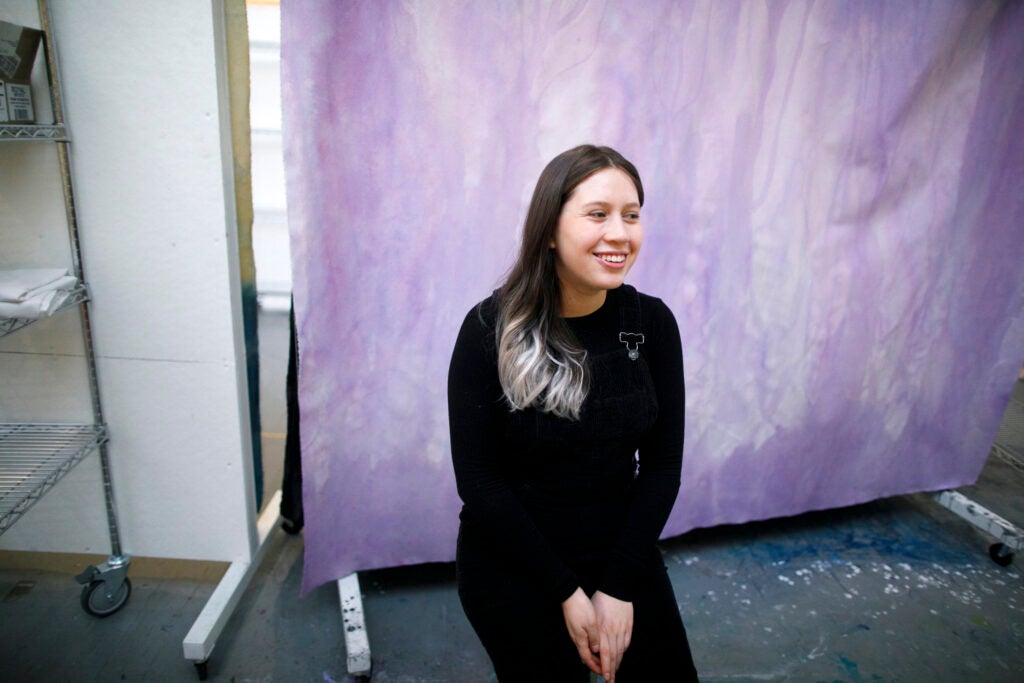
Five large abstract paintings are included in Isabel Haro’s thesis, which is titled “Taking Refuge.”
Photos by Stephanie Mitchell/Harvard Staff Photographer
Abstract art has long served as a vessel for artists — think Hilma af Klint or Wassily Kandinsky — to explore religion and spirituality.
Isabel Haro ’24, a concentrator in art, film, and visual studies with a secondary in music, was inspired to pursue a thesis that explored this topic after taking the course “Spiritual Paths to Abstract Art” with Professor Ann Braude at Harvard Divinity School. Haro, who practices Buddhism, wanted to create a collection of work inspired by her own experiences.
“It’s very hard to talk about spirituality in the contemporary art world. It’s something that a lot of people are not interested in, or actively shy away from,” said Haro. “My intention was to be really diligent and responsible with how I was bringing Buddhism into the art conversation.”
To prepare, she studied other artists and paintings, read Buddhist scripture and poetry, meditated, and sketched. Inspired by color field style and the techniques of abstract painter Morris Louis, Haro played with gravity, standing on a stool to pour ink down the canvas, and laid canvas on the floor to let the paint move in rivulets.
The thesis, titled “Taking Refuge,” includes five large abstract paintings done in paint on muslin and canvas. One is painted with black Sumi ink — the kind used for Zen calligraphy — and uses salt and soap to create textures.
“I spent so much time preparing for this final set of paintings and all of that work prepared me to let these paintings emerge in a natural way,” Haro said. “I learned how valuable it is to work on a project over an extended period of time.”





